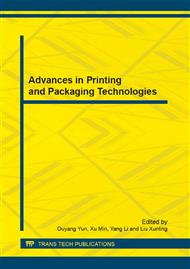p.320
p.324
p.329
p.334
p.340
p.345
p.349
p.355
p.361
The Study on Color Print Quality Attributes of In-Mold Roller Using Digital Inkjet Printing
Abstract:
The In-Mold Roller is a revolutionary printing process by which objects are 3D decorated. The products decorated by In-Mold Roller are protected from water and fading. These kinds of decorations strongly increase the beauty, desirability and value of the objects. The In-Mold Roller is now using either of gravure printing and screen printing to print PET film. However, there are some problems with these two techniques. This research is to investigate the potential use of combining In-Mold Roller with digital inkjet printing in 3D decoration, e.g. in personalized printing services. The study results found show that digital inkjet printing to the PET film and then transfer to the ABS, the solid ink densities (SIDs) of primaries would increase. The tone values increases (TVIs) from highlight and middle (around 0~60%) were generally higher than those in shadows. The shapes and sizes of color gamut were also varied according to different kinds of digital UV inkjet printing processes. Moreover, after transferred, the color gamut became smaller.
Info:
Periodical:
Pages:
340-344
Citation:
Online since:
December 2012
Authors:
Keywords:
Price:
Сopyright:
© 2013 Trans Tech Publications Ltd. All Rights Reserved
Share:
Citation:


